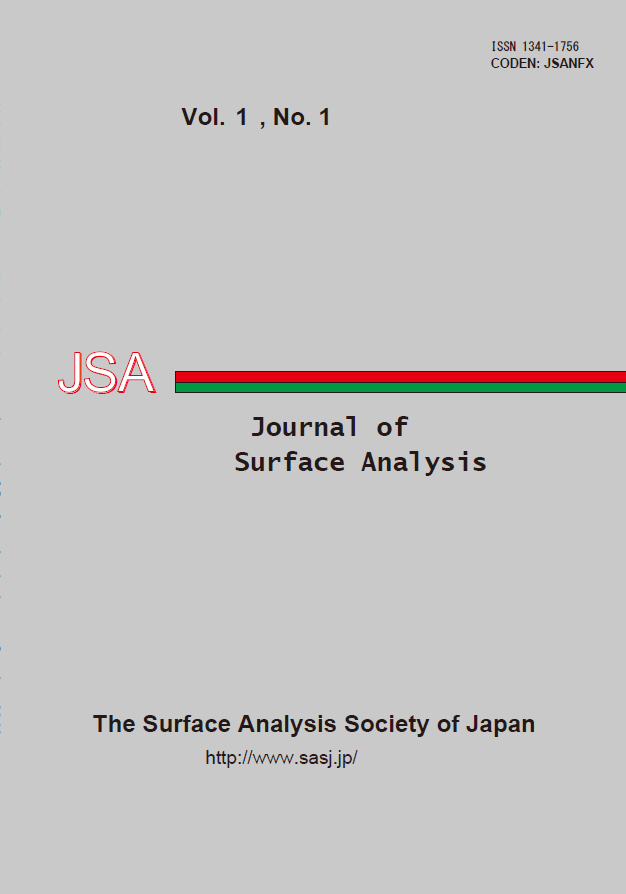All issues

Volume 17 (2010)
- Issue 3 Pages 157-
- Issue 2 Pages 64-
- Issue 1 Pages 2-
Volume 17, Issue 1
Displaying 1-3 of 3 articles from this issue
- |<
- <
- 1
- >
- >|
Paper
-
Kazunaka Endo, Koichiro Hayashi, Tomonori Ida, Daisuke Matsumoto, Nobu ...2010 Volume 17 Issue 1 Pages 2-14
Published: 2010
Released on J-STAGE: September 07, 2011
JOURNAL FREE ACCESSWe used a quantum molecular dynamics {QMD (MD with MO)} due to the force function of MO with the velocity Verlet algorithm using the model oligomers of PE, PP, PS, and PET polymers to obtain theoretical mass spectra of the polymers. The QMD calculation was performed in the thermal energy range of 0.69 - 0.95 eV, and the sampling position data by a time step of 0.5 fs were performed up to 5000 steps. The fragments at the final step of 60 trajectories in the QMD were obtained as positive, negative, and neutral charged ones from the net atomic charge analysis at geometry-optimization of the MO SCF calculations. We can compare the positive ion fragments of polymer models with the experimental distribution of polymers in mass spectra and secondary ionization mass spectra after a few tens of keV of primary heavy metal ion bombardment. We also showed the chemical structures of fragments for PE, PP, PS, and PET polymers in positive ion spectra, unavailable from experimental methods.View full abstractDownload PDF (579K) -
Koichiro Hayashi, Kousuke Moritani, Daisuke Matsumoto, Kozo Mochiji, N ...2010 Volume 17 Issue 1 Pages 15-27
Published: 2010
Released on J-STAGE: September 07, 2011
JOURNAL FREE ACCESSA quantum molecular dynamics (QMD) due to the force function of MO with the velocity Verlet algorithm using the polystyrene (PS) hexamer was performed to simulate secondary ion mass spectra (SIMS) of the polymer. We assumed that the QMD calculation corresponds to the thermal sputtering process in Sigmund proposal, and tried to analyze experimental mass spectra of PS with size-selected Ar gas cluster ion beam (GCIB) bombardments from the calculated mass spectra, because the Ar GCIB bombardments are considered as the sputtering by elastic collisions proposed by Sigmund. The calculated positive ion mass spectra for PS 6mer from the atomic charge analysis of the fragments at the 5000 MD (2.5 ps) step for total 60 trajectories of 0.77, 0.86 and 0.95 eV energy controls seem to be roughly in accordance with the experimental secondary positive ion results with the Ar+ primary ion bombardments. From analysis of energy-dependency (0.43 - 1.03 eV) for the PS model in QMD, the calculated relative intensities of fragments (C2H2+, C3H4+, C4H2+, C6H4+, C8H7+, C9H9+) may almost correspond to the experimental Eatom dependence of relative yields of fragments (C2H3+, C3H3+, C4H3+, C6H5+, C8H7+, C9H7+)View full abstractDownload PDF (518K)
Serial Lecture
-
Sei Fukushima2010 Volume 17 Issue 1 Pages 28-36
Published: 2010
Released on J-STAGE: September 07, 2011
JOURNAL FREE ACCESSOne of the most important items for the analyst is the handling of the numerical data. The almost analysts handle and treat the numeric data, significant figure or dispersion for example, obtained from the measurement in the correct way unconsciously. However, there are many analysts who lose the self-confidence, when they wish to use the description of the statistical terminology. This lecture is intended giving a starting point for giving the self-confidence and learning a systematic knowledge to such people. In present part of this lecture, the way of rounding of the data and the most basic part of the error will be explained.View full abstractDownload PDF (683K)
- |<
- <
- 1
- >
- >|